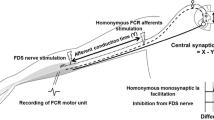Excitability properties at the motor point of the abductor digiti minimi (ADM) muscle were measured using an accelerometer placed on the little finger tip in 31 healthy subjects, and the results were compared with those at the wrist level of the ulnar nerve. ADM motor point stimulation allowed us to demonstrate a significantly shorter strength-duration time constant and smaller threshold changes in deporalizing and hyperpolarizing threshold electrotonus than those at wrist stimulation. At the wrist, hyperpolarizing threshold electrotonus correlated with age (smaller threshold changes), while other excitability indices did not show age-dependent changes at both sites. There were no significant gender differences at these sites. The differences between the wrist and ADM motor point suggest that there are smaller persistent sodium currents and greater inward and outward rectification at the ADM point compared with the wrist. Motor point excitability testing can provide new insights into the pathophysiology of distal motor axons in various peripheral neuropathies and motor disorders.
Similar content being viewed by others
References
S. Kuwabara and S. Misawa, “Acquired and genetic channelopathies: in vivo assessment of axonal excitability,” Exp. Neurol., 263. 368–371 (2015).
S. Isose, S. Misawa, K. Sakurai, et al., “Mexiletine suppresses nodal persistent sodium currents in sensory axons of patients with neuropathic pain,” Clin. Neurophysiol., 121, No. 5, 719–724 (2010).
K. Kanai, S. Kuwabara, K. Arai, et al., “Muscle cramp in Machado-Joseph disease: altered motor axonal excitability properties and mexiletine treatment,” Brain, 126, Pt. 4, 965–973 (2003).
K. Kanai, S. Kuwabara, S. Misawa, et al., “Altered axonal excitability properties in amyotrophic lateral sclerosis: impaired potassium channel function related to disease stage,” Brain, 129, Pt. 4, 953–962 (2006).
K. Shibuya, S. Misawa, K. Arai, et al., “Markedly reduced axonal potassium channel expression in human sporadic amyotrophic lateral sclerosis: an immunohistochemical study,” Exp. Neurol., 232, No. 2, 149–153 (2011).
S. Vucic and M. C. Kiernan, “Axonal excitability properties in amyotrophic lateral sclerosis,” Clin. Neurophysiol., 117, No. 7, 1458–1466 (2006).
M. de Carvalho, M. C. Kiernan, and M. Swash, “Fasciculation in amyotrophic lateral sclerosis: origin and pathophysiological relevance,” J. Neurol. Neurosurg. Psychiatry, 88, No. 9, 773–779 (2017).
K. Shibuya, A. Sugiyama, S. Ito, et al., “Reconstruction magnetic resonance neurography in chronic inflammatory demyelinating polyneuropathy,” Ann. Neurol., 77, No. 2, 333–337 (2015).
S. Kuwabara, H. Bostock, K. Ogawara, et al., “Excitability properties of human median axons measured at the motor point,” Muscle Nerve, 29, No. 2, 227–233 (2004).
J. L. Brigant and A. Mallart, “Presynaptic currents in mouse motor endings,” J. Physiol., 333, 619–636 (1982).
M. Nakata, S. Kuwabara, K. Kanai, et al., “Distal excitability changes in motor axons in amyotrophic lateral sclerosis,” Clin. Neurophysiol., 117, No. 7, 1444–1448 (2006).
J. S. Bae, S. Sawai, S. Misawa, et al., “Differences in excitability properties of FDI and ADM motor axons,” Muscle Nerve, 39, No. 3, 350–354 (2009).
R. Gunther, C. Neuwirth, J. C. Koch JC, et al., “Motor Unit Number Index (MUNIX) of hand muscles is a disease biomarker for adult spinal muscular atrophy,” Clin. Neurophysiol., 130, No. 2, 315–319 (2019).
H. Bostock and J. C. Rothwell, “Latent addition in motor and sensory fibres of human peripheral nerve,” J. Physiol., 498, Pt. 1, 277–294 (1997).
Y. Iwai, K. Shibuya, S. Misawa, et al.,. “Axonal dysfunction precedes motor neuronal death in amyotrophic lateral sclerosis,” PLoS One, 11, No. 7, e0158596 (2016).
M. C. Kiernan, D. Burke, K. V. Andersen, and H. Bostock, “Multiple measures of axonal excitability: a new approach in clinical testing,” Muscle Nerve, 23, No. 3, 399–409 (2000).
K. Shibuya, S. Misawa, H. Kimura, et al., “A single blind randomized controlled clinical trial of mexiletine in amyotrophic lateral sclerosis: Efficacy and safety of sodium channel blocker phase II trial,” Amyotroph. Lateral Scler. Frontotemporal Degener., 16, Nos. 5–6, 353–358 (2015).
S. K. Jankelowitz, P. A. McNulty, and D. Burke, “Changes in measures of motor axon excitability with age,” Clin. Neurophysiol., 118, No. 6, 1397–1404 (2007).
J. S. Bae, S. Sawai, S. Misawa, et al., “Effects of age on excitability properties in human motor axons,” Clin. Neurophysiol., 119, No. 10, 2282–2286 (2008).
J. C. McHugh, R. B. Reilly, and S. Connolly, “Examining the effects of age, sex, and body mass index on normative median motor nerve excitability measurements,” Clin. Neurophysiol., 122, No. 10, 2081–2088 (2011).
I. Casanova, A. Diaz, S. Pinto, and M. de Carvalho, “Motor excitability measurements: the influence of gender, body mass index, age and temperature in healthy controls,” Neurophysiol. Clin., 44, No. 2, 213–218 (2014).
H. F. Carrer, A. Araque, and W. Buno, “Estradiol regulates the slow Ca2+-activated K+ current in hippocampal pyramidal neurons,” J. Neurosci., 23, No. 15, 6338–6344 (2003).
M. Joels and H. Karst, “Effects of estradiol and progesterone on voltage-gated calcium and potassium conductances in rat CA1 hippocampal neurons,” J. Neurosci., 15, No. 6, 4289–4297 (1995).
S. Kuwabara, K. Kanai, J. Y. Sung, et al., “Axonal hyperpolarization associated with acute hypokalemia: multiple excitability measurements as indicators of the membrane potential of human axons,” Muscle Nerve, 26, No. 2, 283–287 (2002).
D. K. Wysowski, C. Kornegay, P. Nourjah, and A. Trontell, “Sex and age differences in serum potassium in the United States,” Clin. Chem., 49, No. 1, 190–192 (2003).
Author information
Authors and Affiliations
Corresponding author
Rights and permissions
About this article
Cite this article
Kristensen, A.G., Shibuya, K., Amino, H. et al. Excitability Properties of Distal Motor Axons in the Human Ulnar Nerve. Neurophysiology 52, 134–139 (2020). https://doi.org/10.1007/s11062-020-09862-5
Received:
Published:
Issue Date:
DOI: https://doi.org/10.1007/s11062-020-09862-5




